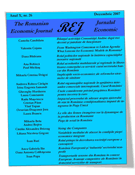Abstract:
One of the most powerful economies in the global economic system is Japan. Nowadays the global economic system is facing many economic and political challenges. Owing to the fact that Japan is one of the most powerful economies, it has to maintain or enhance its economic power in order to face the upcoming challenges. Japanese economic growth is a combination of export growth, private investment and consumption. In order to overcome slow growth, Japan launched “Abenomics”, a policy based on three “arrows”: bold monetary policy, flexible fiscal policy, and a growth strategy. Despite the adoption of Abenomics, Japan’s economy has to overcome three major challenges. First, government debt continues to rise as a percentage of GDP. Second, Japan is faced with declining population growth, which reduces its potential economic growth. The Japanese population is aging fast and, as a result this will limit growth and productivity because of a shrinking and aging labour force. The most important challenge for the Japanese economy is potential economic competition from China in high-technology products. Japan is facing increasing competition from China. The main economic advantage that Japan maintains is its high technological development in several sectors. The aim of this paper is to show whether Japan has a Revealed Comparative Advantage in high-technology exports. The methodology adopted is the theory of comparative advantage.
